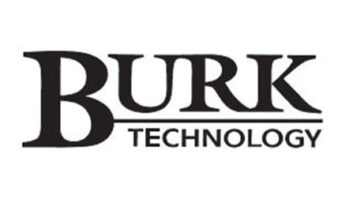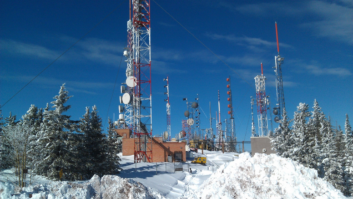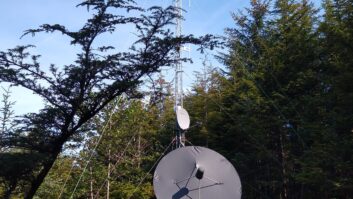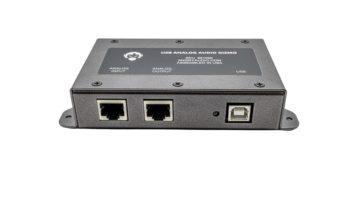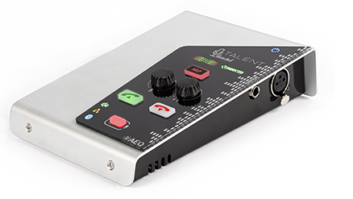Wired for sound and data and more
Jul 1, 2006 12:00 PM, By Doug Irwin
I’ve spent some time in transmitter sites and I always have to shake my head whenever I find old audio cables running around. Typically they are packed with cloth, have a braided shield, thick insulation and, of course, only one pair of wires.
Cable management for the modern radio station
The proliferation of audio over digital cable has made the transportation of audio as well as voice, data, and control easier and more effective….
Thankfully wire and cable technology has come a long way since then, reflecting changes in the systems to which they become a part. Back in the day, at an AM transmitter site, most audio runs (if not all) had transformers on the source and destination. Balance and noise rejection were pretty easy, even in the presence of high-powered transmitters.
Somewhere along the line, single-pair cables with foil shields were introduced, such as the Belden 9451. These were certainly much easier to install than the old braided-shield cable. Another option was multiple pairs of the same type inside one fat cable. While these fat cables certainly saved time during the installation, they had the same issues as the single-pair cables: relatively high capacitance (34pF/foot at 1kHz). The cable was also relatively expensive; plenum rated even more so. Conduit runs had to be made large enough to accommodate multiple runs of the same type.
When the AES3 standard debuted, we had to start using cable with lower capacitance per foot, and due to the nature of the AES data stream, it became necessary to consider the characteristic impedance of the pairs themselves because they effectively became transmission lines. The AES3 standard is 110�, �20 percent, for a balanced pair.
Fortunately for all of us, Ethernet came along with the CAT-5 and later the CAT-5e specifications. CAT-5e has a characteristic impedance of 100 (�15) ohms. Capacitance is specified at no higher than 17pF per foot. These characteristics made it acceptable for use in carrying AES3 signals around the studio facility.

While data cable has increased in common use, audio cable still sees frequent and sometimes abundant use in many facilities.
Now in the construction of a broadcast studio, you have the option of using cheap and readily available CAT-5e, CAT-6 or even CAT-7 wiring to handle everything that runs around the facility � whether it is dc, serial data, audio, AES3 signals or video. Oh yes � you can still use it for Ethernet, of course. Because there are so many applications for it, there are many companies that make it, thus driving down the cost. Because the twist of the wires is fine, and the balance in the pairs is designed to be good (keeping noise from being induced in the pairs themselves, and likewise, keeping the pairs from inducing noise in other nearby pairs) they can be tightly packed together and individual shields around the pairs are not necessary. This shrinks the cable because more pairs can be squeezed in a small diameter. The lack of shielding of individual pairs makes the installation substantially easier as well. This is the way the telephone company had done it for years, but far better.
CAT-rated cables
Belden Wire and Cable offers CAT-5e (7988R (for riser) and 7988P (for plenum)) and CAT-6 cable (7989R and 7989P) that can be used for carrying RGB or VGA signals because of its inherent low-skew 9ns for the CAT-5 and 10ns for the CAT-6. Belden also makes what it calls super-rugged CAT-5e patch cords. These cables can actually be tied in a knot and still pass CAT-5e data. Belden 1034A is the single-jacket, and 1035A is the dual-jacket for even more ruggedness.
Gepco International has its own version of ruggedized CAT-5e cable known as CT504HDX. This cable also is made with a dual-jacket, solid conductors and an extended bandwidth of 350MHz. The cable includes an inner belt that maintains the pair spacing and the electrical specifications while being bent or flexed. Gepco also makes a hybrid cable (RGB6c5) that contains coax (3GHz of bandwidth) and CAT-5e cables (350MHz bandwidth) in one jacket.
Clark Wire and Cable can provide Supercat, which is an outdoor CAT-5e cable suitable for direct burial, installation inside ducts or even lashed to aerial supports. The cable is fully flooded inside an abrasion-resistant and UV-resistant black polyethylene jacket. Optionally, this cable comes as STP with aluminum or steel shielding. Clark also provides CAT-7 cable with four shielded twisted pairs. This cable has a bandwidth of 600MHz and comes in plenum and non-plenum versions.
3M makes a CAT-7 cable called Volition. According to 3M this cable has reduced the pair twist on all four pairs, thus reducing the skew and making it perfect for gigabit Ethernet applications.
ETS makes a line of baluns (which are just transformers) to use CAT-5e and CAT-6 for various applications such as composite video and stereo audio (PV901) or passing RGB video (PV890). The company also makes balun/wall-plate combinations for simplified installation.
The Studio Hub wiring system from Radio Systems uses CAT-5 wiring as its backbone. The system uses a variety of connector panels and interfaces to route audio and data.
Obviously, there are other wire and cable applications in a studio facility as well. You can’t do everything on UTP yet. For example, you will probably still need some version of microphone cable. There are plenty of fancy new types in that category as well.
Wired for sound and data and more
Jul 1, 2006 12:00 PM, By Doug Irwin
Resource Guide
Gepco International manufactures a version of mic cable called X-band. The cable is constructed with video-grade foam dielectric that specifically reduces the capacitance and provides an increased bandwidth. Conductors are finely stranded, oxygen-free copper. It also comes in multiple colors.
Belden has its own new type of mic cable that actually began as AES3 patch cable material. Because of its construction it too has low capacitance. The Belden part number is 1800F.
Mogami offers a new mic cable called Polar Flex. It uses the same internal 105-strand conductors as the company’s standard 2791 stage cable, but with a different outer jacket that allows it to remain flexible down to -40�C. The part number is Mogami 3284.
On the opposite end of the system is speaker cable. Many of us use powered speakers but there are still many instances where heavy-duty speaker cable is needed.
Monster Cable makes many cables of this type but the CL3 plenum-rated caught my attention. It features four individually color-coded 16-gauge conductors (the familiar red, black, white and green) comprised of ultra-fine, highly pure copper strands.
Belden makes its own speaker cable, part number 5T00UP. This 10-gauge cable is UL-listed and NEC rated for in-wall use. Belden 6T00UP is the plenum rated version.
Coaxial cables
One of the most important types of cable around a radio facility is coax. Times Microwave Systems manufactures the LMR series coaxial cables. The cables come in sizes from 0.10 inch up to 1.25 inches. They are exceedingly flexible and therefore the need for jumpers (pigtails) at either end is essentially eliminated. The cable is constructed of closed-cell, dry-nitrogen-injected foam dielectric for low loss and a high velocity factor. The outer is made up of multi-laminar aluminum composite tape bonded to the dielectric, with an outer braid of tinned copper. Times makes a complete system of connectors and installation tools as well.
Belden has taken its coax technology even further with the 7800 series 50� cables. The loss of each of these cables is about the same as the last generation of coax, but the new generation cables are smaller. Belden makes a riser-rated version, a polyethylene jacketed outdoor version, and a hurricane version as well.
The proliferation of new communications technologies has had a tremendously positive effect on the amount and types of construction materials available for a radio studio facility. With its ease of installation and ubiquity, Ethernet cable has actually precipitated changes in technology around the broadcast studio. New and better types of coaxes for use in wireless applications are obviously available for radio station purposes as well. If you haven’t built a facility in the last 10 years, it’s a whole new universe out there.
Resource Guide
Manufacturers of wire, cable, accessories and connectors
3M
www.3m.com
888-3M HELPS
Alpha Wire Company
www.alphawire.com
800-52-ALPHA
Altinex
www.altinex.com
800-ALTINEX
Amphenol
www.amphenol.com
877-267-4366
Audio Accessories
www.patchbays.com
603-446-3335
Belden Wire and Cable
www.belden.com
800-BELDEN1
Bomar Interconnect Products
www.bomarinterconnect.com
973-347-4040
BTX
www.btx.com
800-666-0996
Canare
www.canare.com
818-365-2446
Clark Wire and Cable
www.clarkwc.com
800-222-5348
Energy Transformation Systems
www.etslan.com
510-656-2012
Ensemble Designs
www.ensembledesigns.com
530-478-1830
Gepco International
www.gepco.com
800-966-0069
Heil Sound
www.heilsound.com
618-257-3000
Hosa Technology
www.hosatech.com
714-736-9270
Kings Electronics
www.kingselectronics.com
888-909-5551
Klotz AIS
www.klotz-ais.com
+49 8106 3080
Krone
www.kroneamericas.com
303-790-2619
Lemo
www.lemo.ch
800-444-5366
Liberty Wire and Cable
www.libertycable.com
800-530-8998
Mogami America
www.mogamicable.com
800-800-6608
Mohawk
www.mohawk-cdt.com
800-422-9961
Monster Cable
www.monstercable.com
415-840-2000
Nemal Electronics
www.nemal.com
800-522-2253
Neutrik
www.neutrik.com
732-901-9488
Pomona Electronics
www.pomonaelectronics.com
800-490-2361
Ram Systems and Communications
www.ramsyscom.com
800-779-7575
Redco Audio
www.redco.com
800-572-7280
Switchcraft
www.switchcraft.com
773-792-2700
Techflex
www.techflex.com
800-323-5140
Times Microwave Systems
www.timesmicrowave.com
800-TMS-COAX
West Penn Wire
www.westpenn-cdt.com
800-245-4964
Whirlwind
www.whirlwindusa.com
800-733-9473
Wireworks
www.wireworks.com
800-642-947
Irwin is director of engineering at Clear Channel, Seattle.





